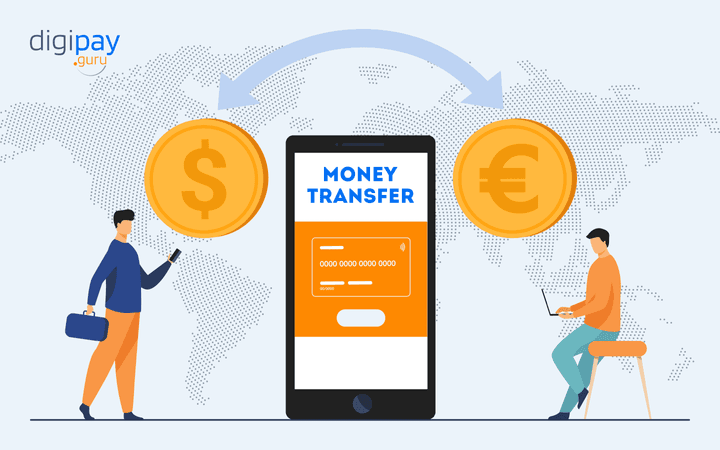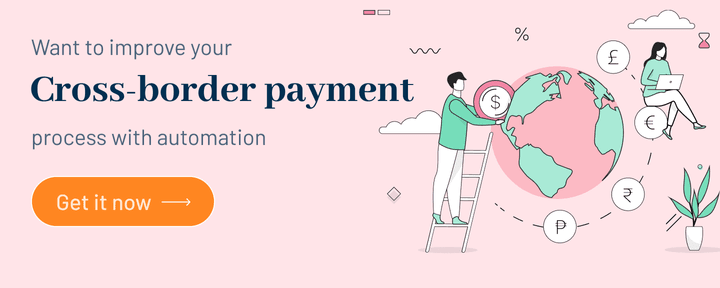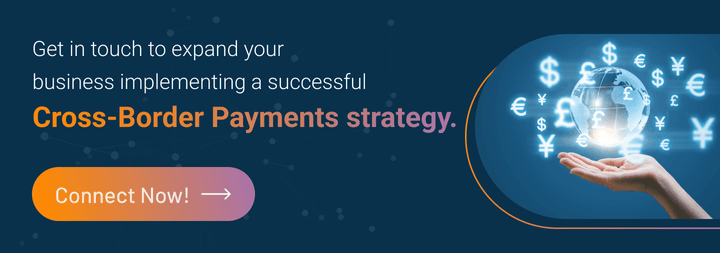With the increase in usage of smartphones and the internet, more and more global browsers are becoming digital buyers. According to reports, the value of estimated cross-border transactions across the globe for B2B, B2C, C2C, and C2B is US$156 trillion.

Witnessing the upward trajectory in the eCommerce industry, international payment transfer solution are here to stay would be no exaggeration. Even considering the pandemic which forced to reset the global payments landscape, eCommerce purchases have only increased.
From India to Italy, the pandemic accelerated the global shift toward digital. People send money overseas 24*7. It’s pretty safe to say that secure cross-border payments will continue to rise.
Countries with low electronic utilization such as Indonesia, Brazil, Bangladesh, Tanzania, etc. are filled with immense scope and strong opportunities for payment growth. On the other hand, the countries with the highest level of internet penetration such as Denmark, Ireland, UAE, etc. are will continue to keep up their cross-border commerce.
Another report by Forrester says that the cross-border commerce payments will spread to at least 29 countries including Latin and North America, Asia Pacific, and Africa by the end of 2022.
Before we dive further into this topic, let’s see what exactly is considered cross-border payments.
What is a cross-border payment?
Secure cross-border payments are monetary transactions where the payee and the recipient are based in different countries. Now, these transactions could be between banks, financial institutions, or simply a customer and eCommerce merchant. Loans, depository receipts, credit cards, eWallet payments, or purchasing from or selling goods and services to other countries can be considered examples of cross-border transactions.
Compared to up until 2020, more and more countries are now opening their borders after the travel restrictions, leading to a shift in the payments industry. The years 2020 and 2021 have improved the global digital landscape, especially the digital payment trends, accelerated open banking, and made moving funds across borders easy when there was a ban on traveling.
Benefits of cross-border transactions
The cross-border transactions have so much to offer to buyers as there is significant upside potential to the whole global payment scenario. Let’s look into some of the benefits of cross-border transactions.
New revenue
No matter how rich the country is, every economy, including the United States of America and Canada, has at least once experienced low to medium growth. Numerous businesses have saturated their home markets. In such scenarios, a cross-border transaction can bring new revenue and possibly profit to the table without stripping apart the home market operations.
Even if you consider acquiring a business in some low-growth remote country, you could see some significant revenue from the acquisition.
Diversified audience
If you are considering making your business a global one, then cross-border transactions can add so much more value to your business as they promote diversification. Just imagine the amount of diversification cross-border transactions can bring to your business in terms of diverse customer base, product/service offerings, etc.
Access to low-cost inputs
So far, various enterprises have leveraged the opportunity of acquiring a small business in a low-cost region and benefitting from it. If you are into a product-based business, the upsides of low-cost labor should be weighed against the additional expenses of international shipping and other logistics and operations-related issues.
Adds more value
When compared to the local businesses, companies that have a presence in more than one jurisdiction are often considered more valuable due to the obvious fact that they have more diversification, growth potential, and better market research. This could be especially an upside for public companies and private equity companies who are preparing their portfolio to sell.
Read More: International Money Transfer Dominates the Digital Landscape
How to make cross-border transactions?
Cross-border transactions are nothing but sending money overseas. Whether it’s a domestic or international purchase, there are typically 6 steps to every transaction.
Purchase of products or services
When you are looking for products or services online out of your country, you will be directed to the checkout page to complete your transaction. Even if you are making a purchase over the phone, you will be cross-border payment solutions getting a link to make your payment. Numerous vendors are now offering checkout pages in their native language to localize the customer experience.
Routing & processing
Once you are done filling in your information on the checkout page, whether you are making a purchase via credit card or debit card, you will get an OTP (One Time Password) regardless to obtain authorization to deduct the amount from your bank account.
Approval or denial status
In this stage, your payment process will either get approved or denied depending on the number of funds available. If your bank account doesn’t have sufficient funds, you will be getting a failed transaction message from the bank and merchant. If your payment is approved, your order goes into fulfillment.
Tracking order
Once the payment is successfully made, you will get a message from the bank and the merchant saying the same. You will be provided a link to track your product or service order status.
Types of cross-border payments
From credit card payments and basic bank transfers to digital wallet solutions and PayPal, there are multiple cross-border payment solutions to choose from. Customers across the globe like to pay in a way that is easy and convenient for them. Apart from custom choices, the customers also like to be ensured that their financial data is in safe hands and will be securely handled.
Credit card payments
Credit cards are one of the easiest and most convenient options for 80% of customers who like to purchase products and services online. If you think from a customer’s point of view, all they have to do is enter credit card information and enter the OTP for the transaction to be verified and successful.
On the other hand, from the merchant side, there would be more work involved as the credit card network and acquiring banks have to convert between two currencies. If the customer is using a global money transfer solution like PayPal, then there would be additional charges or fees that are involved in the payment chain.
International ACH
Also known as Global ACH (Automated Clearing House), this method makes it easier for customers to make payments to out-of-country merchants. This type of payment can be easily made via local banks, BACS, and SEPA. However, a credit card or debit card cannot be used for this method. ACH payments are inexpensive and highly convenient.
The only downside to international ACH payment methods is that they take longer to process. Thanks to their low transaction fee, customers can make funds transfer in huge amounts and can easily set up on a recurring basis.
eWallet
Also known as digital wallet solutions, eWallets are software applications that customers use to pay the merchant. Currently, the most used mobile wallet platforms are Apple Pay, Gpay, PayPal, and Alipay. eWallets do not entirely count as cross-border transactions as it is a digital money service from wallet to wallet. But it will be when the funds are withdrawn from the bank by the recipient.
Wire transfers
Wire transfers take no time to transfer funds from one account to another but they certainly do come with a high transaction fee. If the customer is making a fund transfer of $500, then a fee of $50 would be charged by the bank. For customers who have to transfer large amounts of funds, this may not be the ideal option.
Should you use international payment gateways?
If you are a merchant who is planning to grow internationally, then having an international payment transfer solution is a must. All payment gateways define vital eCommerce infrastructure and what makes those cross-borders transactions’ acceptance easy and possible.
eCommerce merchants planning to grow internationally should evaluate international payment system gateways on numerous factors and parameters such as security, reliability, highly responsive, global accessibility, etc. Latency, up-time reliability, and redundancies are a vital part when selling products and services cross-border so taking transaction speed into consideration will also help in making sure that your buyers are getting a quality customer experience.
Read More: Strengthening payment processing security with Tokenization Technology
For a growing and expanding business, local payments should also be taken into account. No matter what you sell, your customers will pay through methods that are easy, convenient, and familiar to them. So as a merchant, you should ensure that your payment gateway provider is able to offer a wide range of payment methods.
In addition to that, reporting is another crucial element when you are considering payment gateways. International payment gateway reporting should be dynamic, on-time, and accurate as there would be a lot of sensitive information that goes through the gateway.
Challenges with cross-border transactions
First and foremost, merchants would be concerned about the additional costs they incur and the time it takes to accept those secure cross-border payments, and dealing with a hundred other things might sound like a complex process. Receiving payment as early as possible and at an affordable fee is a top priority for merchants, hence, it is highly important to make sure that the merchants work with a reliable payment service provider who can ease the process.
They also have to make sure that the payment service provider is transparent about the transaction charges and foreign exchange fees so that the merchants don’t end up incurring hidden costs.
High costs
As cross-border transactions involve too many intermediaries, it can sometimes get ridiculously costly to send money from one country to another. There are also regulatory costs that come into the picture.
Slow transactions
Usually, cross-border payments through conventional banking institutions take anywhere between two to five working days for a successful payment process. This is assuming, there are no hiccups in the process. But then again, there are too many entities involved in one single transaction hence the turnaround time is comparatively slow.
Security concerns
Cross-border or not, every customer across the globe wants to confidently send money without bothering about security and safety issues. And unfortunately, cross-border transactions are naturally prone to suffer from high-level security breaches.
Lack of transparency
Cross-border transactions lack transparency. Why? The primary reason is customers want 100% visibility regarding the costs, fees, and deductions involved in cross-border transactions as they want to ensure they are incurred any hidden costs.
Get a foolproof platform for all your digital transactions.
How to save money with cross-border transactions
Partner with Money Transfer Solutions
One way to save those additional costs is by partnering with global money transfer solutions that can help you with effortless cross-border transactions. Of course, they certainly have low transaction fees when compared to a traditional bank, but they also reduce AP (Accounts Payable) headcount or redirect hose employees toward other related activities when you partner with a platform that automates invoices along with global payments.
Find suitable PSPs
Merchants can also minimize the overhead costs if they find a PSP that can provide invoice automation, and this will lead to more money-saving opportunities in the future as they streamline the end-to-end AP workflow. Also, all the regular, routine work that is usually handled by the accounts payable team now can be automated, resulting in touchless activities.
Configure as per convenience
As an alternative, merchants can set payments in a way that the payee bears the transaction fee. Almost all global payments platforms are offering services at a minimum fee, so the payee will most likely absorb the fee.
Final thoughts
As a merchant, if you are serious about expanding your business on a global scale, then it is recommended to gather as much information as possible about cross-border payments. Finding out what methods your customers like will help you in offering them the best customer experience.
The mechanism and logistics of cross-border payments may sound complicated, but it will be worth your time if you partner with an experienced and reliable payment service provider who can help you with transaction challenges.





